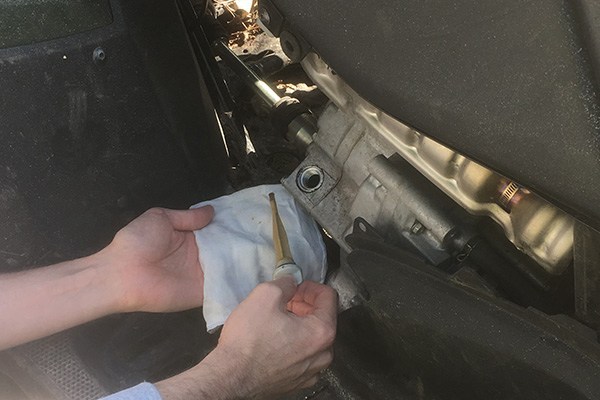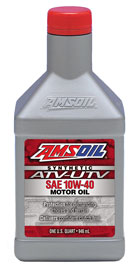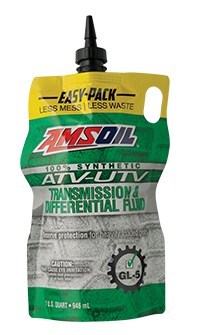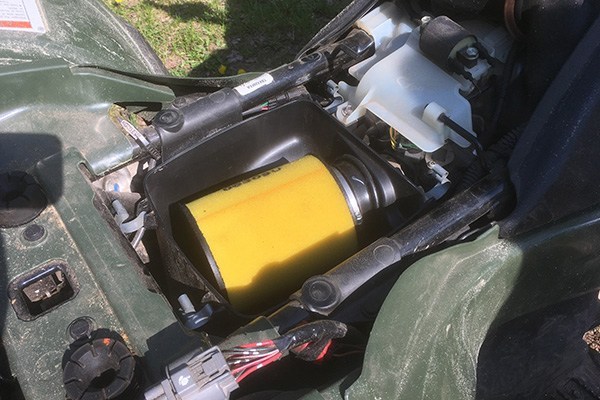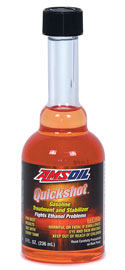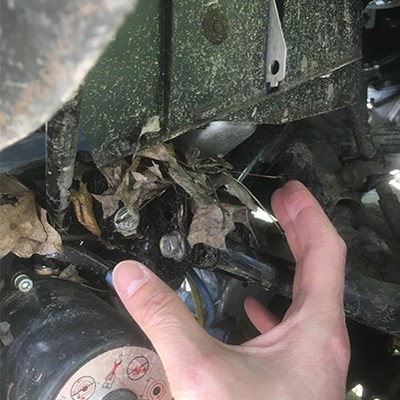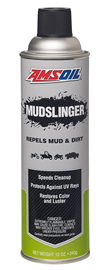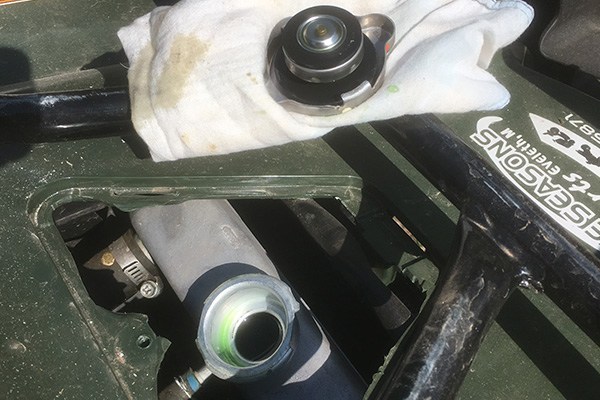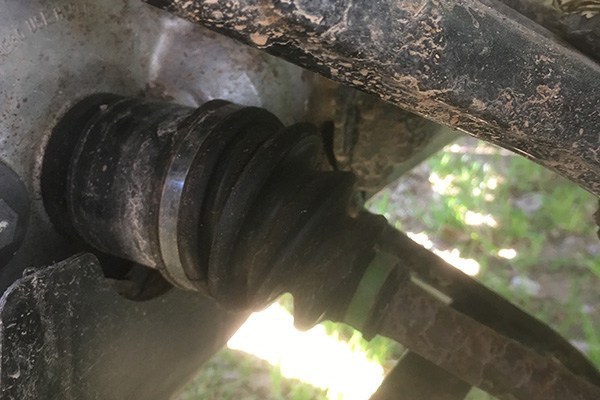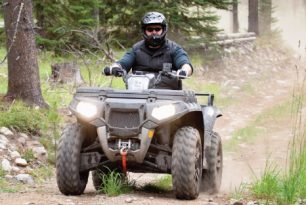Your ATV or UTV needs your attention – 7 things to do
ATVs and UTVs aren’t cheap. And neither should be your approach to maintenance if you want your machine to deliver peak performance and last for years.
Fortunately, ATV and UTV maintenance boils down to a handful of relatively simple practices any do-it-yourselfer with basic tools can accomplish. No reason to waste money on maintenance at the local shop if they overcharge for doing things they were suppose to do and didn’t.
Here are our top 7 ATV/UTV maintenance tips.
Check/change the oil
Sumps on ATV’s and Side-by-Sides are not all too big so with such a small capacity for motor oil please keep an eye on it! Check it frequently and try not to go past the manufacturers change interval.
Changing the oil and filter is especially important in ATVs and UTVs used for hard work or when used in wet weather conditions.
The added stress we heap on our machines increases heat. And heat causes oils formulated for standard service to lose viscosity (become thinner). Thinner oil than what your engine is designed to use can fail to develop an oil film of adequate thickness or strength to protect against wear.
Extreme heat also invites sludge and performance-robbing deposits. Sludge can clog oil passages and starve the engine of oil, while deposits can cause power loss due to sticking piston rings.
Changing oil is the best defense against engine wear and power loss. Be sure to upgrade to a good synthetic oil, too. We have you covers with 6 new viscosities and oil change kits!
Shop AMSOIL Synthetic ATV/UTV Oil
Synthetics don’t contain the impurities inherent to conventional lubricants, meaning they deliver better performance and last longer. Their naturally tough base oils resist extreme heat and maintain a strong protective film better than conventional products.
And don’t balk at the higher price, either. – Well actually in MANY cases we are less in cost than the dealerships.
Match your ATV or UTV here
Match Your VehicleProduct GuidesThink of synthetic oil as just another performance upgrade for your machine. You don’t think twice about spending a few hundred dollars on a snowplow or beefier winch. The few extra dollars spent on better oil is nothing by comparison – and it’ll help your machine perform better and last longer.
Use this button to save more on your AMSOIL purchases
Save 25%Join for More Perks Preferred customer ProgramChange the differential fluid
It’s the same story inside the front and rear differentials.
The extra weight and stress of hard work and performance riding concentrate intense pressure on gears. The lubricant coats the gear teeth during operation, guarding against metal-to-metal contact and wear. The added stress, combined with high heat, can break the fluid film and literally squeeze the lubricant from between the gears, leading to wear.
Change differential fluid according to the recommendations in the owner’s manual. And, like motor oil, upgrade to a good synthetic. It’ll provide improved film strength despite intense pressures to protect gears and bearings in the toughest conditions, helping your machine last for years.
Anyone who’s changed differential fluid knows it can be a hassle: tough-to-reach fill holes, bloody knuckles and gear lube spilled everywhere.
The AMSOIL easy-pack reduces mess, hassle and frustration when changing gear lube. It makes ATV/UTV maintenance much easier, as the video shows.

Shop AMSOIL Synthetic ATV/UTV Transmission & Differential Fluid
Traditionally, enthusiasts use a gear-lube pump in these scenarios. But that’s one more tool to buy. Plus, much of the gear lube is wasted inside the pump and it makes a mess during storage.
Its flexible design allows you to access fill holes in tight spaces and around obstacles that prevent use of the rigid conical bottles common to the gear-lube market.
Check/change air filter
An engine needs three things to run: fuel, spark and air. Most of us forget about air since we don’t have to pay for it.
But a dirty or clogged air filter can choke off airflow and reduce performance or cause the engine to quit completely.
Here’s an analogy to illustrate: Go outside and run around your house. If you’re in decent shape, it shouldn’t be that difficult.
Now, run around your house while breathing through a straw. Restricting airflow into your lungs makes it much more difficult.
The same principle applies inside your engine. A dirty air filter restricts airflow and reduces engine performance. It also allows debris to enter the engine, which can lead to wear.
Check your owner’s manual for recommendations on how often to change the air filter. Check the filter periodically and change it if it’s excessively dirty.
Pro Tip: Ensure the air filter is firmly seated and correctly installed. If not, the engine will ingest dirt, which acts like sandpaper and scours the cylinders, rings and bearings.
Stabilize the fuel
Gas can break down in as little as 30 days. When it does, varnish forms inside the carburetor, which clogs the tiny fuel passages. Eventually, varnish will prevent adequate fuel-flow and keep you machine from starting.
For best performance, add stabilizer to every tank of fuel. If you know you’re going to burn through a tank quickly, like during a day-long ride, you can skip the stabilizer. But many enthusiasts run on the same tank of fuel for months.
Personally, I use my ATV primarily for hauling firewood around my property, meaning it runs in fits and starts. It’s common to use the same tank of fuel for several months.
Stabilizer inhibits oxidization that occurs when fuel sits for long periods. It helps prevent varnish to keep the carburetor clean and the fuel flowing properly.
Pro Tip: Most gasoline contains ethanol, which can corrode carburetor components and damage rubber gaskets and fuel lines. For best performance use 91-octane, ethanol-free gas. If you use 87-octane gas that contains ethanol, treat it with a fuel additive designed to prevent ethanol problems, like AMSOIL Quickshot.
Wash! Clean it at The End Of The Day
True, your ATV or UTV is meant to get dirty. But it shouldn’t remain dirty.
Wash off mud and debris, especially after a particularly messy (i.e. fun) ride.
Caked mud and dirt traps moisture, which can hasten rust formation on metal components. It can also pack in around the engine or differentials, which reduces heat-transfer. This causes the temperature to increase, which speeds the rate at which the lubricant oxidizes, or breaks down.
Mud, leaves and other debris packed against the radiator can also cause the engine to run hotter, reducing efficiency.
Take a pressure washer to your machine if you can. Also, consider using an undercoat product that eases cleanup, such as AMSOIL Mudslinger. It provides a protective layer of armor against mud, dirt and snow, making cleanup with a low-pressure garden hose easy.
Pro Tip: After washing, run your machine so engine heat can dry any water that entered the exhaust or the areas around the spark plug boots and coil.
Check coolant level and condition
Here’s another easily overlooked ATV/UTV maintenance practice. It doesn’t help that the coolant reservoir is often buried where you can’t readily see it.
Check the coolant level in the radiator. Inspect fluid condition. If it contains sludge or slime, it’s time for a change. Putting it off can result in debris clogging the narrow coolant passages in the engine and preventing optimum cooling. This can lead to the engine overheating. Engine parts expand when they grow hot, which can result in scuffing and wear.
And now as of 2024 we have a specific ATV coolant as the manufacturers are using unique metals which other coolants are not preventing corrosion. Try the new Powersports Coolant!
While you’re at it, check the coolant hoses for abrasions or wear. Replace them as needed before they break and leave you stranded.
Inspect tires, CV boots, etc.
Finally, walk around your machine once a month or so and check the following:
- Tire pressure and condition
- CV boots for cuts or leaks
- Brake line condition
- Lights
- Brake fluid level
This can help you spot any issues before they turn into expensive problems. It’s also a good idea to lubricate any pivot points and linkages with a good spray lubricant, like AMSOIL MP. Doing so is a simple way to ensure your machine operates as designed for the long haul.


